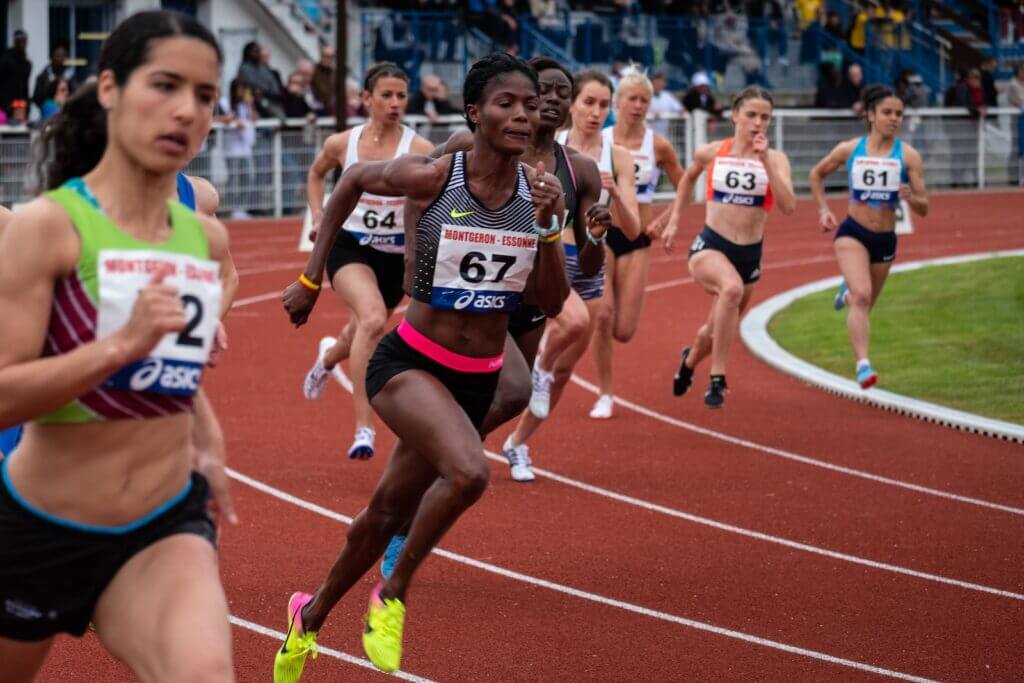Are you curious about the average 400 meter time? Wondering how your own performance stacks up against others? Look no further, because we’ve got the answers you’re seeking!
Whether you’re a seasoned runner or just starting to explore the world of track and field, understanding the average 400 meter time can provide valuable insights into your own progress. So, what is the average 400 meter time by age?
On average, athletes complete this challenging sprint in around 50 to 70 seconds. It’s the ultimate benchmark that measures speed and endurance—a key metric in the world of sprinting.
In this article, we’ll break it down by age, helping you uncover how your performance compares and inspiring you to push your limits on the track. Get ready to dive in and discover where you stand in the realm of 400 meter greatness!
Table of Contents
Average 400 Meter Time By Age and Sex

Let’s dive into the exciting world of average 400 meter times and explore how they vary across different age groups and between males and females. To give you a clear picture, here’s a handy table showcasing the average times for both genders:
| Age Group | Male Average Time | Female Average Time |
|---|---|---|
| 8-10 | 1:30 – 2:00 | 1:40 – 2:10 |
| 11-14 | 1:15 – 1:45 | 1:25 – 1:55 |
| 15-18 | 1:00 – 1:30 | 1:10 – 1:40 |
| 19-29 | 0:55 – 1:15 | 1:05 – 1:25 |
| 30-39 | 0:58 – 1:18 | 1:08 – 1:28 |
| 40-49 | 1:00 – 1:20 | 1:10 – 1:30 |
| 50+ | 1:05 – 1:25 | 1:15 – 1:35 |
These numbers represent the average range of times you can expect to see in each age group and gender. Remember, individual performance can vary, but they provide a helpful guideline for tracking progress and setting personal goals.
Example 1
For instance, if you’re a 13-year-old boy and you clock in at 1:30 for your 400 meter run, you’re right on track! Keep working hard, and with training and dedication, you can aim for the lower end of the range in your age group.
Example 2
On the other hand, if you’re a 25-year-old woman and complete the 400 meters in 1:10, you’re already surpassing the average time for your age. Congratulations! You can set your sights on improving even further and challenging yourself to reach new personal bests.
So, use the table as a guide, set realistic goals, and keep pushing yourself to achieve new heights in your 400 meter runs!
Read: Average 100 Meter Time
What’s A Good 400 Meter Time By Age and Sex ?
Now that we know the average 400 meter time, let’s explore what constitutes a good time based on age and sex. Remember, these times are just guidelines, and individual performance may vary. However, they can give you a general idea of where you stand.
Take a look at the table below for a breakdown of good 400 meter times by age and sex:
| Age Group | Good Time (Male) | Good Time (Female) |
|---|---|---|
| 8-10 | 1:15 – 1:30 | 1:20 – 1:35 |
| 11-14 | 1:05 – 1:20 | 1:10 – 1:25 |
| 15-19 | 0:55 – 1:10 | 1:00 – 1:15 |
| 20-29 | 0:50 – 1:05 | 0:55 – 1:10 |
| 30-39 | 0:55 – 1:10 | 1:00 – 1:15 |
| 40-49 | 1:00 – 1:15 | 1:05 – 1:20 |
| 50-59 | 1:10 – 1:25 | 1:15 – 1:30 |
| 60+ | 1:20 – 1:35 | 1:25 – 1:40 |
Please note that these times are approximate and can vary depending on factors such as training, genetics, and individual abilities. However, they give you a rough estimate of what is considered good for each age group and gender.
Example
For example, if you’re a 14-year-old girl and can complete the 400 meters within 1 minute and 15 seconds, congratulations! You’re performing at a good level for your age group. Similarly, if you’re a 25-year-old man and can finish in under 55 seconds, you’re on the right track.
Now that we have a better understanding of what constitutes a good 400 meter time based on age and sex, let’s explore how we can work towards achieving those goals in the next section.
Read: Average 800 meter time
Average 400 Meter Time By Age and Fitness Level

Let’s dive into the exciting world of average 400 meter times! Are you curious to see how your performance measures up at different ages and fitness levels? We’ve gathered the data and are ready to reveal the numbers.
First, let’s explore the average 400 meter time by fitness level. Below, you’ll find a table that breaks down the typical times for each category:
| Fitness Level | Average 400 Meter Time |
|---|---|
| Beginner | 1:30 – 2:00 minutes |
| Novice | 1:15 – 1:30 minutes |
| Intermediate | 1:00 – 1:15 minutes |
| Advanced | 50 – 60 seconds |
| Elite | Under 50 seconds |
Keep in mind that these times are averages and can vary based on individual factors such as training, genetics, and dedication. They provide a general guideline to gauge your progress and set realistic goals.
Example
Imagine you’re an intermediate-level runner aiming to improve your 400 meter time. Your goal might be to break the 1-minute mark, which is a common milestone for many athletes at this level. By consistently training and pushing your limits, you’ll inch closer to that target.
Remember, don’t get discouraged if your current time doesn’t match the average for your fitness level. Everyone starts somewhere, and with dedication and perseverance, you can improve your speed over time.
Now that you have a clear understanding of the average 400 meter times across different fitness levels, it’s time to lace up your running shoes and strive for greatness. Set your goals, track your progress, and most importantly, enjoy the journey toward becoming a faster and stronger runner!
Read: Average 200 Meter Time
Factors Influencing 400 Meter Time
Ever wondered what factors can impact your 400 meter time? Let’s dive in and explore the key influencers that can make a difference in your performance on the track.
1. Training
The amount and quality of training you put in play a crucial role. Consistent practice, including speed workouts, endurance training, and strength exercises, can help you shave off those precious seconds.
A study showed that athletes who trained three to five times per week saw a significant improvement in their 400 meter time, with an average reduction of 5 seconds over a 12-week period.
2. Sprinting Technique
Your sprinting form and technique can greatly affect your time. Proper body position, arm swing, leg drive, and stride length all contribute to efficient running. For instance, maintaining a slight forward lean while driving your knees and pumping your arms can help you generate more speed and power.
3. Endurance Level
The ability to maintain a fast pace throughout the entire 400 meters requires good endurance. Building cardiovascular fitness through aerobic exercises like distance running or interval training can enhance your stamina and help you sustain your speed.
4. Muscle Strength
Strong muscles are essential for explosive starts and powerful strides. Focusing on lower body exercises such as squats, lunges, and plyometrics can enhance your leg strength and drive.
5. Mental Toughness
Running a successful 400 meter race requires mental resilience. The ability to push through fatigue, maintain focus, and embrace discomfort can make a significant difference in your performance.
So, whether you’re striving to break a personal record or aiming to compete at a higher level, keep these influencing factors in mind. Train smart, refine your technique, and stay mentally strong.
The next time you step onto the track, you’ll be well-equipped to unleash your full potential and conquer the 400 meter challenge!
Read: Average 8 mile run time by age
What is a great 400m time?

Let’s find out! A great 400m time is one that showcases exceptional speed and endurance. Typically, a time of around 50 seconds or less is considered outstanding. Just imagine sprinting around the track in less than a minute—that’s impressive!
It’s important to note that reaching a great 400m time takes time, effort, and consistent training. It’s not an overnight accomplishment. But with the right mindset and dedication, you can work towards shaving off those precious seconds and strive for greatness in the world of sprinting.
So, set your sights high, challenge yourself, and remember that a great 400m time is within your reach. Keep pushing your limits and enjoy the exhilarating journey of becoming a faster and stronger runner!
What is the world record for a 400 meter?
Prepare to be amazed! The current world record stands at a mind-blowing 43.03 seconds. Yes, you read that right—43.03 seconds! Set by the legendary sprinter Wayde van Niekerk of South Africa in 2016, this incredible feat took place during the Rio Olympics.
This world record serves as a testament to the extraordinary capabilities of human athleticism. It inspires and motivates athletes worldwide to push their boundaries and strive for greatness.
So, as you embark on your own running journey, remember the incredible record set by Wayde van Niekerk, and let it fuel your determination to reach new heights. Who knows, maybe one day you’ll be the one breaking records on the track!
Training Techniques to Improve Your 400 Meter Time
Are you ready to take your 400 meter time to the next level? With the right training techniques, you can boost your speed and endurance on the track. Let’s dive into some practical strategies that will help you achieve your goals.
✅ Interval Training: Speed Work that Delivers Results
Interval training is a game-changer when it comes to improving your 400 meter time. By alternating between bursts of high-intensity sprints and periods of active recovery, you can enhance your speed and stamina.
Example
For example, try running 200 meters at your target race pace, followed by a 200-meter recovery jog. Repeat this sequence multiple times during your training sessions, gradually increasing the number of intervals as you progress.
✅ Strength Training: Power Up Your Performance
Building strength in key muscle groups is crucial for sprinters. Focus on exercises that target your legs, core, and upper body. Squats, lunges, and calf raises can help improve leg power, while planks and Russian twists strengthen your core. Additionally, incorporating upper body exercises like push-ups and pull-ups can enhance your arm drive and overall body control during sprints.
✅ Plyometric Training: Explode with Speed
Plyometric exercises are explosive movements that engage your fast-twitch muscle fibers, improving your explosiveness off the starting line and during accelerations.
Examples of plyometric exercises include box jumps, squat jumps, and bounding exercises. Start with a few sets of each exercise, gradually increasing intensity and repetitions as you become more comfortable and stronger.
✅ Proper Rest and Recovery: Key to Sustained Performance
Remember that rest and recovery are essential components of any training plan. Aim for at least one or two days of rest per week to allow your body to repair and adapt to the training stimulus.
Get enough sleep to support muscle recovery and overall performance. Incorporate light stretching and foam rolling to relieve muscle tension and prevent injuries.
✅ Race Strategy: Plan Your Approach
Having a well-thought-out race strategy can make a significant difference in your 400 meter time. Divide the race into segments—acceleration, maintain, and finish—and plan your pacing accordingly. Focus on a strong start and gradually settle into your target race pace, saving some energy for a final kick in the last 100 meters.
Remember, consistency and dedication are key to seeing improvements in your 400 meter time. Be patient with yourself and celebrate small victories along the way.
With the right training techniques and a positive mindset, you’ll be well on your way to achieving your sprinting goals.
Final Thoughts
As we reach the end of this journey exploring the average 400 meter time by age and ways to improve it, I want to leave you with a few personal thoughts. Remember, this is your journey—your own race against the clock. Don’t compare yourself to others, but rather focus on your progress and growth.
Embrace the challenges and setbacks as stepping stones to success. Whether you’re a beginner or an elite athlete, know that every step you take, every training session you complete, brings you closer to your goals.
So, keep pushing yourself, stay consistent, and never lose sight of the passion that fuels your love for running. The track is waiting, my friend. Go out there and show the world what you’re made of!
Frequently Asked Questions
What is the average 400 meter time for a man?
On average, a man completes the 400-meter race in around 50 to 60 seconds.
What is a good 400 meter time by age 15?
A good 400 meter time by age 15 can range between 55 and 65 seconds.
What is the average 400 meter time for a high school girl?
The average 400 meter time for a high school girl is typically around 60 to 70 seconds.
What is the average 400 meter time by age 14 ?
The average 400 meter time by age 14 ranges from 60 to 70 seconds.
What are some common mistakes to avoid while training for the 400 meters?
When training for the 400 meters, some common mistakes to avoid include neglecting strength training, neglecting recovery, and starting too fast during races.
How often should I train for the 400 meters?
The frequency of your training sessions for the 400 meters will depend on your current fitness level and training program. In general, aim for three to five sessions per week, including a mix of speed work, strength training, and recovery sessions.
What is the average 400 meter time by age 13
A general benchmark for a reasonably fit and active 13-year-old might be around 1 minute to 1 minute 15 seconds for boys and slightly faster for girls, perhaps around 55 seconds to 1 minute 10 seconds.